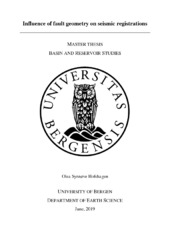Influence of fault geometry on seismic registrations
Master thesis
Permanent lenke
https://hdl.handle.net/1956/20413Utgivelsesdato
2019-06-26Metadata
Vis full innførselSamlinger
- Master theses [106]
Sammendrag
One of the main objectives of seismic interpretation is the identification and positioning of structural discontinuities, e.g. faults, fractures, pinch-outs and karsts. Seismic diffractions encode the seismic response from such small-scale events and may thus provide valuable information about the geometry of structural discontinuities which are small compared to the seismic wavelength. As such, this information may lead to seismic super-resolution. Despite the many advantages of utilising the diffracted wavefield, seismic diffractions are typically considered as noise and are intentionally suppressed during conventional seismic processing. If we could utilise the properties of diffracted seismic waves for the estimation of the velocity model, seismic imaging will have a potential for improvement. In order to carry out such a process, a reliable method for detecting diffractions is essential. In this study, a method for detecting diffracted waves on pre-stack offset gathers, using a diffraction detection algorithm, is proposed. This algorithm is tested on synthetic and real seismic data, processed in the pre-stack domain. To facilitate diffraction detection, a reflection focusing technique is applied to separate diffractions from specular reflections. The novelty of my approach is to incorporate semblance calculations as a quantitative measure of detection capability. Here I show that by generating semblance plots and comparing them to pre-stack depth migrated sections - where regions where diffractions are likely to occur are identified – I am able to quantify the extent of diffraction detectability. Furthermore, the results demonstrate how the diffraction detection algorithm successfully detects diffractions, despite variations in seismic velocities and amounts of coherent and incoherent noise. Consequently, the findings of this study may be of importance in the process of recovering structural details smaller than the seismic wavelength, which could significantly assist seismic interpreters and lead to major geological discoveries.
